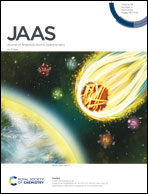Multiplexed elemental bioimaging with quadrupole ICP-MS and high-frequency laser ablation systems†
Abstract
The advent of fast washout and high frequency laser ablation systems has reduced blurring and greatly improved the throughput of analyses performed using laser ablation-inductively coupled plasma-mass spectrometry (LA-ICP-MS). However, historical laser synchronisation issues have limited the number of elements aquired in a single run when using quadrupole-based ICP-MS. Aliasing noise results from incorrect synchronisation between the MS acquisition time and laser firing rate, and is made more prevalent by fast washout cells. Oversampling at high Hz is a possible solution to aliasing, yet remains unexplored for the context of multiplexed elemental bioimaging. In this paper we determined the minimum laser firing rates required to prevent aliasing for any MS dwell time, and provide an equation for calculating aliasing noise. The effects of oversampling were explored using simulations and the ablation of gelatine standards and murine brains. Higher firing rates were found to reduce aliasing and increase signal, but increased the risks of sample damage and raised backgrounds. Aliasing was found to be insignificant at firing rates and dwell times greater than 200 Hz and 2 ms for a typical (20 ms full-width at 10% of maximum) fast washout cell. At these parameters, the noise from aliasing was overwhelmed by noise from other sources and synchronisation was a non-issue. This allowed facile selection of acquisition and dwell times to increase the number of targeted elements or favour those with low sensitivity. Nine elements were collected in a single analysis of a murine brain at 25 pixels per second with no visible aliasing. Use of these parameters will greatly increase throughput and multiplexing capabilities when using high frequency laser ablation with quadrupole-based ICP-MS.



 Please wait while we load your content...
Please wait while we load your content...